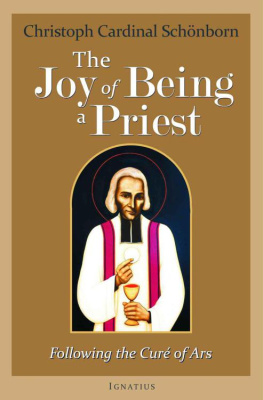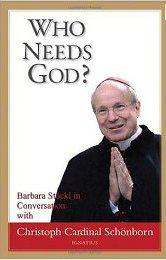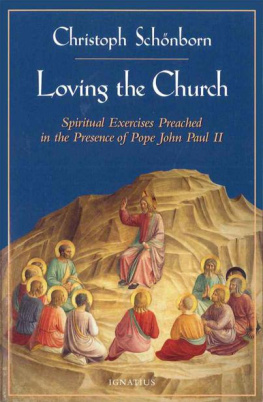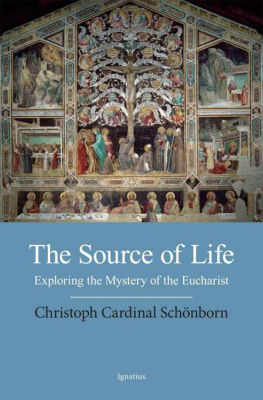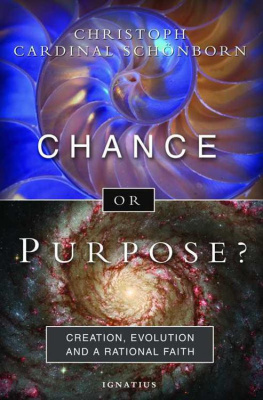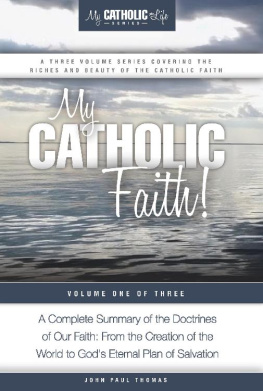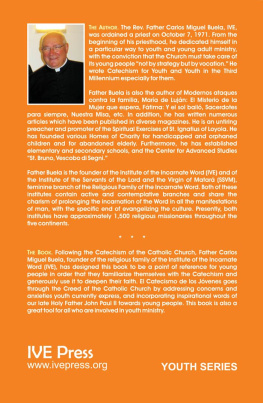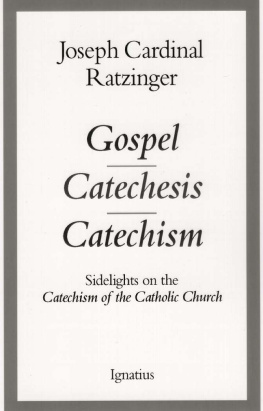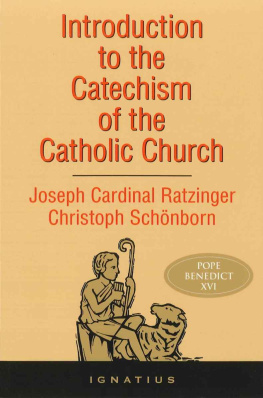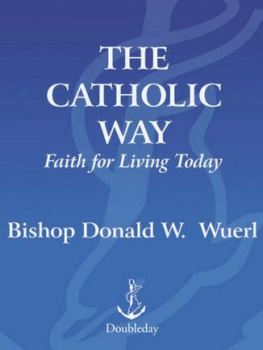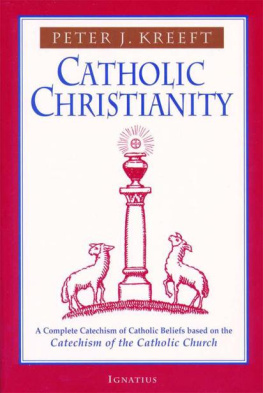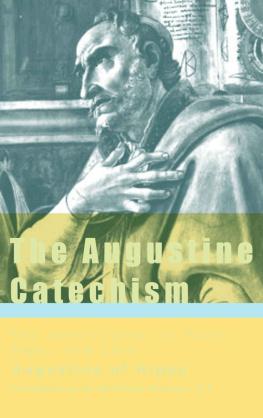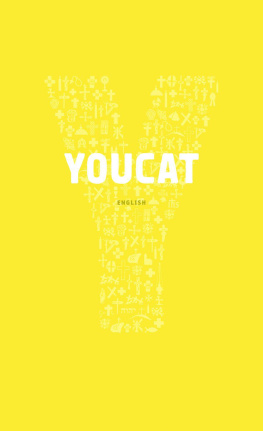Living the Catechism of the Catholic Church
CHRISTOPH SCHNBORN, O.P.
Living the
Catechism of the Catholic Church
A Brief Commentary on the Catechism
for Every Week of the Year
V OLUME O NE
TRANSLATED BY DR. DAVID KIPP
IGNATIUS PRESS SAN FRANCISCO
Title of the German original:
Herzstcke unseres Glaubens
Das Credo im Katechismus der Katholischen Kirche
1994 Wiener Dom-Verlag Gesellschaft m.b.H., Vienna
Cover by Riz Boncan Marsella
1995 Ignatius Press, San Francisco
All rights reserved
ISBN 978-0-89870-560-7
Library of Congress catalogue number 95-75670
Printed in the United States of America
Contents
Preface
Over the course of a year, from week to week, fifty-two times, it fell to me to publish a weekly article in the Vienna Catholic newspaper on Essential Elements of the Faith. The Catechism of the Catholic Church was my point of reference. That is the origin of this commentary now in the form of a bookupon Part One of the Catechism .
The object of the following pages is, in each short section, to bring into relief and clarify an important element of the faith. This book is offered as a help in the personal or group study of the Catechism . For this it is important not to lose sight of the overall context of each section.
For faith is whole. It has only one heart, one center: Jesus Christ, the Son of the living God. Christ must therefore also be the center of catechesis whose object is putting people... in communion... with Jesus Christ: only he can lead us to the love of the Father in the Spirit and make us share in the life of the Holy Trinity (CCC 426), for in him are hid all the treasures of wisdom and knowledge (Col 2:3). In a certain sense, the essential elements of the faith have their origin in a treasury of the heart of Jesus. This heart is the symbol of that love with which the divine Redeemer continually loves the eternal Father and all men without exception (CCC 478).
The brief presentations and reflections will have achieved their goal if they lead to a deeper surrender of faith, a greater love of the heart of Jesus (CCC 158, 2669).
Christoph Schnborn, O.P.
Auxiliary Bishop of Vienna
Feast of the Transfiguration of the Lord
August 6, 1994
To know Godthe life of man
Father,... this is eternal life, that they may know you, the only true God, and Jesus Christ whom you have sent (Jn 17:3). These words are quoted in the epigraph to the Catechism of the Catholic Church , whose English edition was published in May 1994. To know God means to live. This knowing is the goal of our life. In Sacred Scripture, that goal is also expressed as to see God (CCC 1028).
Saint Teresa of Avila once said, as a child, I want to see God! And she is supposed to have added, In order to see him, I must die (CCC 1011). In the Old Testament, God says that man shall not see me and live (Ex 33:20). To see God, to know Godthat means to live, but it is a living that is no longer of this world. Here on earth, in our life of pilgrimage, what John says holds true: No one has ever seen God (Jn 1:18). Hence, this earthly life is still not the full, true life; it is like a shadow, passing as if windblown, even when it lasts for many years.
We are, however, destined for another life, one that signifies unimaginable happiness. In his Confessions (which are a kind of life confession and a testimony, a praising of Gods incomprehensible love), Saint Augustine says of this other life, When I am completely united to you, there will be no more sorrow or trials; entirely full of you, my life will be complete ( Confessions 10, 28, 39; CCC 45). It is for this happiness that we were created, and this happiness is what the restless heartreferred to by that same Augustineis seeking (CCC 30).
In the old catechism, the first question was: For what purpose did God create us?; and the answer was: God created us to know, to love, and to serve him, and so to come to paradise (cf. CCC 1721). This simple sentence is like a secure rope on a steep mountain pathwaysomething that one can hold on to when things become uncertain. I have known cases in which people who had not practiced their religion for years, even decades, were suddenly reminded, in the midst of some profound crisis in their lives, of catechism sentences like this from their childhood, words that they had then learned by heartperhaps without much thoughtand that now suddenly surfaced from memory as helpful, saving precepts.
In a quite simplemanner, this first catechetical truth simultaneously illustrates the meaning of the Catechism : it is a pathway, a help toward a happy life, an aid to living, a signpost, a trail map set out with precise destinations. For the early Christians, Christian life was simply the Way (cf. Acts 9:2; 19:9, 23; 24:14, 22)not just one way among many, but that Way which God himself indicates to us, which leads unerringly through this life, and which allows us to arrive with certainty at our goal. In the following pages, it is this Way that will be discussed, with its beauties and joys, but also its dangers. Here, the Catechism of the Catholic Church will serve as a kind of map.
What is the Catechism?
In India, at the start of 1993, I was presented with a copy of a book that has become a best-seller there. It is entitled Daddy, Am I a Hindu ? This question is put into the mouth of a boy who is asking his father every possible sort of question about their religion, Hinduism. The result is a kind of catechism for Hindus, in the familiar form of questions and answers, which has obviously aroused the interest of a great many peopleI even noticed that it was being sold by a department store in the United States. Is that not a sign of the times? Evidently it is not only Christians who are searching today for a deeper and better knowledge of their own religion. In a world that is growing smaller, in which borders and distances are being overcome by technology and communication, many people are asking again about their own roots, about what foundations can support that house which is their life. This need not be quickly dismissed as fundamentalism. It is a good, healthy reaction when people begin to seek anew for the foundations of their own religion and, thus, of their own lives.
Books of this kind have existed since the beginning of Christianity. It was only later that they were named catechisms, but they served the same purpose from the first: to lay, and to reinforce, the foundations of the Christian faith. These concise, comprehensible outlines of Christian religious teaching were usually the result of rich experience in practical transmission of the faith (CCC 8). Although no book can replace that living ministry, books can be of assistance to it. Personal communion with Christ and a love of man that springs from the faith are the most convincing means of catechesis (CCC 427). Pope John Paul I, who was a gifted catechist, dedicated his book on catechesis to his mother: In loving memory of my mother, my first catechist (cf. CCC 25).
This is not to suggest that catechisms are superfluous. In order to be able to transmit the faith, we must be familiar with it, and simple, clear outlines of the doctrines of the faith are necessary for that (CCC 23). In view of the great uncertainty, as well as ignorance, that often prevails regarding religious matters, the bishops asked the Holy Father, at the Synod in 1985, whether it might not be advisable that a book on the faith be composed, a catechism for the entire Church, which would provide a reliable source of guidance, a central orientational point, for catechesis (CCC 10): the Catechism of the Catholic Church .
What purposes can this new Catechism serve? The first and most important goal is surely a deepening of personal faith. We can love only that which we know, while the more we love, the more deeply we wish to know; and out of this arises a desire to communicate that which we love to others. Christ is the center of catechesis; living communion with him is the goal of all catechesis (CCC 426). This is the first aim of the Catechism : to know the love of Christ that surpasses all knowledge (cf. Eph 3:19). That is why the Catechism begins with the profession of faith, the Creed, which speaks of God the Father, his Son Jesus Christ, and the Holy Spirit. Hence, the short meditations that follow will be concerned primarily with the heart of our faith, with Christ. It is from him that all Christian life originates (CCC 478).
Next page

